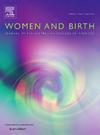Economic evaluation and budget impact analysis of midwifery-led care for low-risk pregnancies in Portugal
IF 4.1
2区 医学
Q1 NURSING
引用次数: 0
Abstract
Background
Midwifery-led models of care for low-risk pregnancies are associated with improved outcomes for mothers and babies, without additional adverse effects. These models are also considered more cost-effective than doctor-led or shared-care approaches.
Problem
In Portugal, midwifery-led antenatal care is not widely implemented, and its economic impact remains unexplored.
Aim
To estimate the cost implications of implementing a midwifery-led antenatal care model for low-risk pregnancies in Portugal, compared to standard doctor-led care, from the perspective of the Portuguese National Health Service.
Methods
A decision-tree model was developed to simulate the antenatal period through birth, comparing midwifery-led and doctor-led care. The eligible population included low-risk pregnant women. Outcomes included preterm birth, spontaneous vaginal birth, instrumental birth, and caesarean section. A budget impact analysis estimated the financial implications for the national health service. Sensitivity and scenario analyses tested the robustness of findings by varying key parameters and assumptions.
Findings
Midwifery-led care was estimated to cost €23.08 million, compared to €39.35 million for doctor-led care, resulting in projected savings of €16.27 million. Lower rates of preterm birth, instrumental deliveries, and caesarean sections, alongside increased spontaneous vaginal births, accounted for €10.07 million in cost-offsets. Total savings were estimated at €26.34 million, or €340 per pregnancy/birth, representing a 25.8 % reduction in maternity-related expenditure.
Discussion and conclusion
Midwifery-led care presents a promising, cost-saving alternative to the current standard of care in Portugal, with the potential to improve clinical outcomes and optimize resource use.
Further research is needed to evaluate long-term economic and health impacts beyond birth.
葡萄牙助产士主导的低风险妊娠护理的经济评价和预算影响分析。
背景:助产士主导的低风险妊娠护理模式与母亲和婴儿的预后改善有关,没有额外的不良反应。这些模式也被认为比医生主导的或共享的医疗方式更具成本效益。问题:在葡萄牙,助产士主导的产前保健没有得到广泛实施,其经济影响仍未得到探索。目的:从葡萄牙国家卫生服务的角度,与标准的医生主导的护理相比,估计在葡萄牙实施助产士主导的低风险妊娠产前护理模式的成本影响。方法:建立决策树模型,模拟产前至分娩过程,比较助产士主导和医生主导的护理。符合条件的人群包括低风险孕妇。结果包括早产、自然阴道分娩、器械分娩和剖腹产。一项预算影响分析估计了对国家保健服务的财政影响。敏感性和情景分析通过改变关键参数和假设来检验结果的稳健性。研究结果:助产士主导的护理费用估计为2308万欧元,而医生主导的护理费用为3935万欧元,预计可节省1627万欧元。较低的早产、器械分娩和剖腹产率,以及自然阴道分娩的增加,抵消了1007万欧元的成本。节省的总费用估计为2634万欧元,即每次怀孕/分娩340欧元,与产妇有关的开支减少了25.8% %。讨论和结论:助产士主导的护理提出了一个有前途的,节省成本的替代方案,目前的护理标准在葡萄牙,具有改善临床结果和优化资源利用的潜力。需要进一步的研究来评估出生以外的长期经济和健康影响。
本文章由计算机程序翻译,如有差异,请以英文原文为准。
求助全文
约1分钟内获得全文
求助全文
来源期刊

Women and Birth
NURSING-OBSTETRICS & GYNECOLOGY
CiteScore
7.20
自引率
13.20%
发文量
371
审稿时长
27 days
期刊介绍:
Women and Birth is the official journal of the Australian College of Midwives (ACM). It is a midwifery journal that publishes on all matters that affect women and birth, from pre-conceptual counselling, through pregnancy, birth, and the first six weeks postnatal. All papers accepted will draw from and contribute to the relevant contemporary research, policy and/or theoretical literature. We seek research papers, quality assurances papers (with ethical approval) discussion papers, clinical practice papers, case studies and original literature reviews.
Our women-centred focus is inclusive of the family, fetus and newborn, both well and sick, and covers both healthy and complex pregnancies and births. The journal seeks papers that take a woman-centred focus on maternity services, epidemiology, primary health care, reproductive psycho/physiology, midwifery practice, theory, research, education, management and leadership. We also seek relevant papers on maternal mental health and neonatal well-being, natural and complementary therapies, local, national and international policy, management, politics, economics and societal and cultural issues as they affect childbearing women and their families. Topics may include, where appropriate, neonatal care, child and family health, women’s health, related to pregnancy, birth and the postpartum, including lactation. Interprofessional papers relevant to midwifery are welcome. Articles are double blind peer-reviewed, primarily by experts in the field of the submitted work.
 求助内容:
求助内容: 应助结果提醒方式:
应助结果提醒方式:


